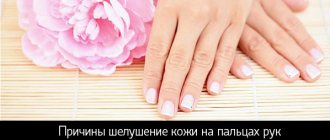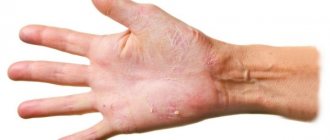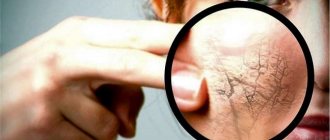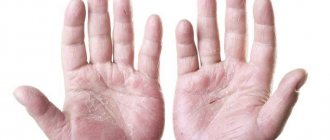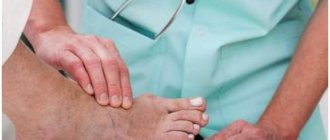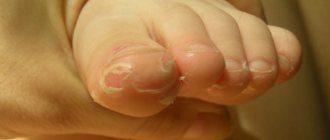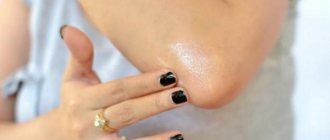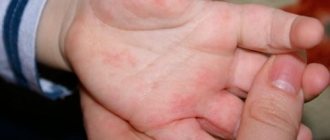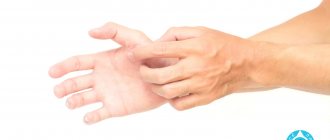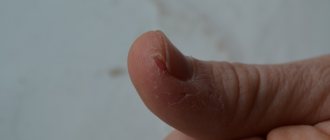Rough heels on the feet are a phenomenon that worries many women and men, especially in the summer. Besides the fact that it brings a lot of unpleasant sensations, it also looks ugly. Peeling skin on the heels can catch the fabric of clothing and tear nylon tights. Sometimes the heels hurt and bleed. To understand why the skin on the heels peels, you should know the factors causing it and acceptable methods of elimination.
Why do my feet itch and peel?
The cause of exfoliation and peeling of the epidermis can be external factors, malfunctions of internal organs, infections in the form of bacteria, viruses and fungi, and simple failure to comply with hygiene rules. If you detect the problem in time and establish the true cause of the disorder, you can quickly get rid of the problem and restore the condition of the skin.
Impact of external factors
Often the lower limbs of adults begin to peel and peel due to exposure to the external environment. The reason is wearing low-quality, uncomfortable shoes made of unnatural material, and frequent use of high heels.
The soles may peel due to prolonged wearing of hosiery and socks. If shoes are made of poor quality material, the skin on the feet cannot fully breathe due to clogged pores.
During certain weather conditions, severe dry skin may also occur. In frosts and low humidity, adults and children often develop a kind of allergic reaction in the form of peeling. Therefore, during cold weather it is necessary to monitor the condition of your feet and do not forget to take care of them.
- If cosmetic products contain harmful additives and are of poor quality, they can not only dry out the feet, but also provoke allergies. In this case, additional treatment with antihistamines will be required.
- When cosmetics contain alkaline substances, it also dries out the skin. Shower products can cause a similar reaction on your feet if you use them every day.
- The epithelium on the feet may peel if the indoor air is too dry. This can be avoided by frequently ventilating the room and using humidifiers.
Poor nutrition
Since the condition of the skin directly depends on the functioning of the internal processes of the body, pathology can be caused by metabolic disorders, lack of vitamins and minerals.
Feet can itch and itch if the human body does not have enough fluid. Smoked and salty foods also increase thirst. To prevent your skin condition from changing, you need to drink at least 2.5 liters of water per day, not including tea and soup.
Common problems that lead to dry skin on the legs include a lack or, conversely, an overdose of nutrients. When the body lacks vitamin B and D, the heels begin to peel and itch, and the skin on the toes peels off.
Important addition: What are mycoses: types and classification, treatment of the disease
Hypervitaminosis can also cause skin problems. In particular, an increased concentration of vitamin C often dries out the skin.
A similar reaction is sometimes caused by certain microelements, the content of which is exceeded.
How to get rid of rough heels
All methods of therapy work with their constant use to get rid of roughness. To get rid of it, we take an integrated approach to solving the problem:
- Care
- Masks
- Crema
- Ointments
Recommendations on how to eliminate rough heels:
- Buying good shoes. It must allow air to pass through so that the skin can breathe. Wear only natural socks and tights. Do not walk barefoot, as this will cause the skin to peel off even more.
- Selection of a complex of vitamins. When the body receives the required vitamins, the skin on the heels will become better. In addition, this will strengthen immune function and eliminate other problems caused by vitamin deficiency.
- Everyday care. Heels should be lubricated with emollient ointments, and baths should be carried out using sea salt. Do not forget that regular foot treatments are an important rule. It is recommended to use exfoliating agents and scrapers. Also, if your heel is peeling off, folk recipes help a lot.
- We remove peeling by purchasing pedicure socks from a Japanese manufacturer. The socks contain lactic acid, which acts as a peeling agent. After using them, the skin peels off on its own.
- Reconsider the table. Add fruits and vegetables, cereals, vegetable oils, and seafood to your diet.
- Do exercises to improve blood circulation, massage your feet, play sports to improve your metabolism. Thus, this will improve the health of the skin.
- After cleansing your heels, you should always thoroughly wipe your feet and lubricate them with ointment. Masks with lotions are recommended to be used up to 2 times for 7 days. For hygiene of the lower extremities, it is recommended to buy mild soap.
- Preparing your heels for summer should be done in winter, which will prevent your feet from peeling.
By using all these recommendations regularly, you can achieve the desired result.
What diseases cause peeling skin on the soles of the feet?
Very often, the reason why itching, whitening and peeling appears on the feet is a fungal infection. Symptoms of the disease can be seen already at the initial stage, when the legs begin to itch.
The presence of fungus can be judged if the nail plates become deformed and thicken. At the same time, the epithelium peels off, the feet itch and hurt. A later stage of infection is accompanied by rashes and hyperemia of the skin.
Infection with the fungus occurs in public places through direct contact with an infected person or his things. Spores can also be found on objects in a bathhouse, sauna, shower, or swimming pool.
Athlete's foot
A very common fungal pathology is athlete's foot. It can be recognized by deep cracks between the toes and on the heels.
Additionally, the disease is accompanied by redness of the skin, intense itching, and an unpleasant odor. Numerous areas of peeling are observed on the feet.
If the disease is left untreated for a long time, in severe cases the cracks give way to bleeding wounds, and the nails become severely deformed.
Rubromycosis of the foot
Also, the skin on the legs begins to peel off when infected with rubromycosis of the feet. This fungus is considered popular; it affects not only the skin between the toes and on the heels, but also the nails themselves.
The disease is weeping in nature, and the person feels burning and itching. The skin folds on the fingers and between them are covered with small cracks.
If treatment is not started in time, the epidermis begins to peel off, and multiple bleeding and difficult-to-heal wounds appear on the feet. Infection with the fungus occurs through close contact with the source of infection and sharing household items.
Candidiasis of the feet
This fungus on the feet is not common, but infection with it is possible. The disease is caused by pathogenic yeast-like fungi Candida, which are found in the natural microflora of the body of every person.
Under the influence of certain factors, microorganisms are activated and begin to grow sharply. This leads to the formation of an inflammatory focus, which is sometimes localized on the legs and arms.
A fungal infection develops in diabetes mellitus, dysbacteriosis, hepatitis C, HIV infection, disruption of the gastrointestinal tract, chronic infectious processes in the body, long-term use of antibiotics and other drugs.
The affected skin peels off severely, itches, and after a while the feet become covered with small wounds and microcracks. Since fungal activity is primarily caused by decreased immunity, the patient needs to strengthen the immune system.
Important addition: Oak bark for feet from sweat and odor due to fungus
Locations
The dermis can peel off in different areas of the foot. Depending on the location, the cause can be determined.
If your heel cracks:
- avitaminosis;
- fungus;
- insufficient humidity in the room;
- contact with synthetics;
- uncomfortable shoes;
- age;
- chlorinated water;
- climate change;
- allergy;
- stress;
- taking medications.
The feet peel under the influence of the same factors, but diabetes and various endocrine disorders are added to them.
Why does the skin peel off on my toes? The problem occurs as a result of bacterial or fungal infections. Less commonly, the condition is provoked by allergies. The dermis may itch, turn red or yellow, and emit a foul odor.
Other reasons
There are other factors that lead to excessive dry skin on the legs. Dermatological problems are often caused by excessive sweating. This condition indicates the presence of disturbances in the functioning of internal systems, so complex treatment is required.
Psoriasis is a lifelong disease that also increases peeling of the skin on the feet. This disease cannot be treated, but the condition of the skin can be improved through proper nutrition, leading a healthy lifestyle, as well as taking certain medications and using medicinal ointments.
When wearing uncomfortable and low-quality shoes, the skin is injured, calluses form, which causes dryness and itching. Also, heels often crack due to disruption of the valves due to varicose veins.
If a child complains of peeling skin on his legs, the reasons may be the same as in adults. However, in infants, the top layer of the epidermis often separates when dermatitis develops.
It could also be an allergy to synthetic clothing and cheap, low-quality cosmetics.
Diagnosis of fungal infection
To identify the cause of flaky skin on the legs, the doctor prescribes a laboratory and instrumental examination. The doctor also examines the skin, assesses the severity of the lesion and symptoms, studies the medical history, and asks the patient about the presence of provoking factors.
To study the general condition of a person, the patient undergoes a general and biochemical blood test, and the blood is also studied for hormones and bacterial cultures. Additionally, feces and urine are examined for the presence of infection in the body. If internal organs are damaged, the patient undergoes an ultrasound examination.
Particles of the affected skin are subjected to histological examination; for this purpose, skin scrapings are taken. If blisters are found on the feet, a bacterial culture of their fluid is performed.
Factors provocateurs
Before you begin to eliminate symptoms, it is important to determine the primary syndrome of peeling feet.
There is no need to panic if peeling on your feet becomes noticeable; this is a fairly common problem. Effective assistants have been sufficiently studied and tested.
But, before starting to eliminate the symptoms, it is important to determine the primary syndrome of peeling feet. The following are possible:
- Ichthyosis.
- Psoriasis.
- Dermatitis.
- Erythema.
- Lichen.
- Diseases of internal organs (kidneys, digestive organs).
- Scarlet fever.
- Lack or excessive amounts of vitamins and microelements in the body (primarily vitamin A, E and zinc);
- Fungal infections.
- Allergic reactions.
- Secondary syphilis, etc.
A classic symptom of vitamin A and E deficiency is the seasonal appearance of peeling in the area of the feet.
Among all the indicated reasons, when visiting a dermatologist, people often hear that it is a fungus.
Hormonal levels also play a significant role. Thyroid hormones and sex hormones are especially important. An excess or deficiency of these elements in the body contributes to dry, flaky feet. This is why such disorders cause the skin of the feet to peel. An example would be hypothyroidism.
Women during menopause, whose hormonal levels are significantly disrupted, are prone to similar reactions.
Among all the indicated reasons, when visiting a dermatologist, people often hear that it is a fungus. Treatment in this case is expected to be long and complex. There are no independent options for getting rid of the disease, only drug treatment after consulting a doctor.
How to treat peeling skin on the feet
In the presence of fungal diseases, special creams, gels and ointments are used. The most effective topical drugs include Nystatin, Exoderil, Ketoconazole. Severe lesions of the feet are eliminated by undergoing a course of treatment with Lamisil or Itraconazole tablets.
If severe itching and burning is observed, antihistamines are prescribed, including Suprastin, Zyrtec, Zodak. Before using the medicine, you should definitely read the instructions and study the description to make sure there are no contraindications.
In case of dermatitis, eczema, psoriasis and other skin diseases, they are treated with steroid medications. Local anti-inflammatory ointments Fenistil and Bepanten are also used. You can get rid of itching with corticosteroid medications.
To alleviate the patient’s condition, it is recommended to use proven traditional methods of therapy.
- To disinfect the skin, you need to do foot baths with the addition of potassium permanganate. To do this, the substance is diluted in water heated to 40 degrees until a dark color is obtained. The legs are immersed in the liquid and kept for 20 minutes. After the foot is thoroughly dried, a medicinal ointment is applied to the skin and cotton socks are put on the feet.
- Moisturizing and nourishing masks are excellent for softening the skin of the lower extremities. Two egg yolks are mixed with warm sunflower or olive oil in the amount of several spoons. The mixture is thoroughly beaten and applied to the washed feet, the feet are wrapped in polyethylene on top and insulated with socks. After an hour, the product is washed off.
- Add 50 ml of chamomile decoction to three tablespoons of baby cream. At the same time, two tablespoons of starch are diluted in water until the consistency of sour cream is obtained. The prepared mixtures are combined and spread on the feet. The feet are wrapped in plastic film. After 30 minutes, the product is washed off.
- Freshly squeezed carrot and beet juice are added to the rich cream. The product is applied to the feet and left for 40 minutes.
- Also, foot fungus can be effectively treated with a foot bath with the addition of iodine, soda, vinegar or salt.
Important addition: Treatment of nail dystrophy: photos and causes of thinning
